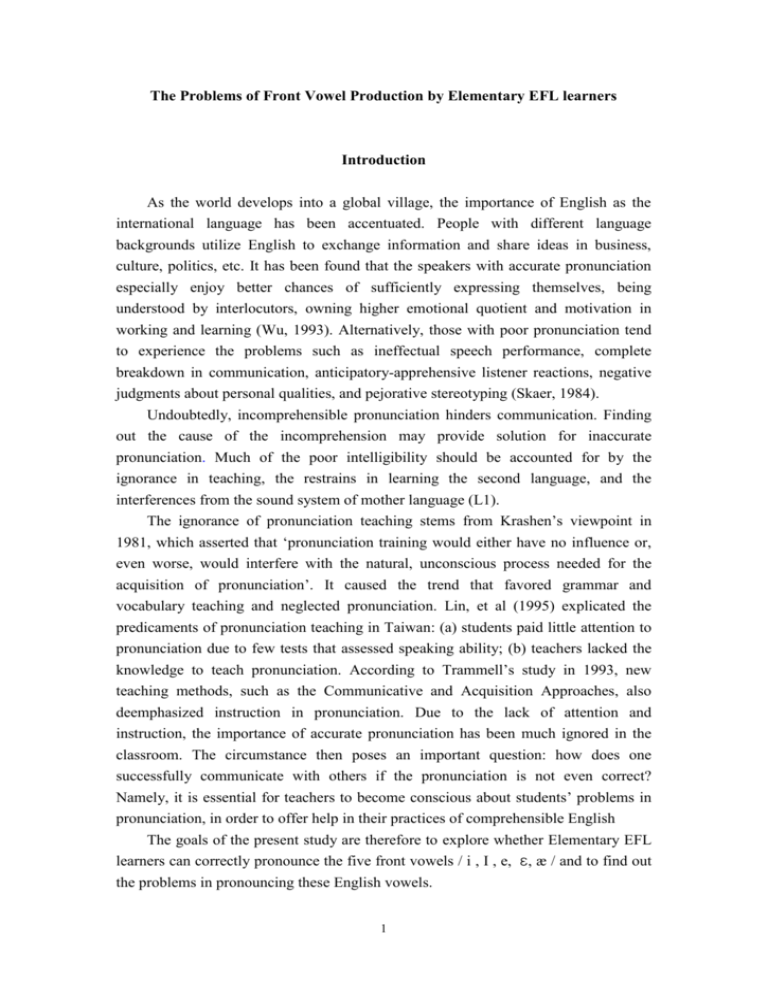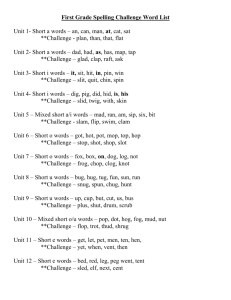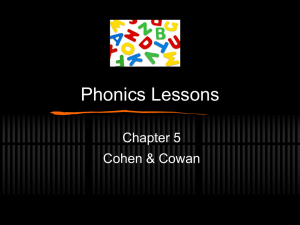CHAPTER 1
advertisement

The Problems of Front Vowel Production by Elementary EFL learners Introduction As the world develops into a global village, the importance of English as the international language has been accentuated. People with different language backgrounds utilize English to exchange information and share ideas in business, culture, politics, etc. It has been found that the speakers with accurate pronunciation especially enjoy better chances of sufficiently expressing themselves, being understood by interlocutors, owning higher emotional quotient and motivation in working and learning (Wu, 1993). Alternatively, those with poor pronunciation tend to experience the problems such as ineffectual speech performance, complete breakdown in communication, anticipatory-apprehensive listener reactions, negative judgments about personal qualities, and pejorative stereotyping (Skaer, 1984). Undoubtedly, incomprehensible pronunciation hinders communication. Finding out the cause of the incomprehension may provide solution for inaccurate pronunciation. Much of the poor intelligibility should be accounted for by the ignorance in teaching, the restrains in learning the second language, and the interferences from the sound system of mother language (L1). The ignorance of pronunciation teaching stems from Krashen’s viewpoint in 1981, which asserted that ‘pronunciation training would either have no influence or, even worse, would interfere with the natural, unconscious process needed for the acquisition of pronunciation’. It caused the trend that favored grammar and vocabulary teaching and neglected pronunciation. Lin, et al (1995) explicated the predicaments of pronunciation teaching in Taiwan: (a) students paid little attention to pronunciation due to few tests that assessed speaking ability; (b) teachers lacked the knowledge to teach pronunciation. According to Trammell’s study in 1993, new teaching methods, such as the Communicative and Acquisition Approaches, also deemphasized instruction in pronunciation. Due to the lack of attention and instruction, the importance of accurate pronunciation has been much ignored in the classroom. The circumstance then poses an important question: how does one successfully communicate with others if the pronunciation is not even correct? Namely, it is essential for teachers to become conscious about students’ problems in pronunciation, in order to offer help in their practices of comprehensible English The goals of the present study are therefore to explore whether Elementary EFL learners can correctly pronounce the five front vowels / i , I , e, ε, æ / and to find out the problems in pronouncing these English vowels. 1 Research Questions This present study aims to examine the following research questions: (a) What are the problems for Elementary EFL learners in pronouncing the five English Front vowels? (b) What are the causes of their pronunciation problems? Literature Review This section reviews literature relevant to the research topic. Brief introductions of the vowels in English and Mandarin are first conducted, followed by a comparison of the vowel systems across the two languages. Vowel System of English On the basis of Teng’s categorization of English vowels (2004), there are fourteen monophthong vowels, which can be distinguished by the following three dimensions: tongue frontness, tongue height, and tenseness, as shown in Table 1. Tongue frontness refers to the part of tongue involved when a vowel is articulated, which divides the vowels into three categories--front, central, and back. Tongue height indicates how high the tongue is raised in pronunciation—high, mid, low. In addition to the tongue movement, tenseness is another feature for distinction. From Table 1, there is a pair of tense and lax phonemes in each of the following cells, high-front, mid-front, high-back, and mid-back. Respectively, they are /i, I/, /e, ε/, /u, U/, and /o, /. Tense vowels require greater tension of muscle, which stretches the articulation of sounds to more extreme peripheral positions, much different from centered lax vowels. Table 1 Vowels of English High Mid Front Central Back Unrounded Unrounded rounded Tense i u Lax I U Tense e o Lax ε Low æ Note. From Lee (2007,p. 23). 2 a Vowel System of Mandarin Chinese Table 2 demonstrates the vowel system of Mandarin Chinese by Teng (2004). The seven simple vowels in Mandarin Chinese can also be categorized by the two dimensions used for English vowels—tongue height and tongue frontness. However, tenseness does not play a role here. Instead, lip rounding serves as a feature for distinction of the vowels with the same tongue movement, such as /i/ and /y/. It is consistent with Lee’s (2007) categorization of the Mandarin vowels--tongue height, tongue advancement, and lip rounding. Table 2 Mandarin Simple Vowels High Front ㄧ (i) /ㄩ(y) Mid ㄝ(e) Central Back ㄨ(U) ㄜ/ㄛ( ) ㄚ(a) Low spread/round spread spread/round Note. From Teng (2004,p. 36). Comparison of English and Mandarin Vowel Systems There are five vowels common to the languages of Mandarin and American English (Chen et al.2001), including /i, e, u, o, a/. Alternatively, the remaining six English vowels that do not occur in Mandarin are /I, ε, æ, , U, /. It is predictable that the L2 American English vowels not found in Mandarin are likely to be produced inaccurately by Mandarin speakers. Flege et al (1997) confirmed the prediction by measuring F゚and F1, F2 frequencies of the four vowels / i, I, ε, æ / produced by the speakers of the two languages, and found that Mandarin subjects showed the least accuracy in producing vowels not found in L1, especially, / I, ε, æ /. A number of studies have examined the influence of Mandarin as L1 on English as L2. The lack of the feature ‘tenseness’ has been considered one of the major causes to inaccuracy (Tiee, 1969, Beebe, 1984). Lee (2007) compared the vowel system of English and Mandarin, and noted that the lack of the distinguishing feature ’tenseness’ in Mandarin caused the Mandarin speakers to ignore the distinctions of tense and lax vowels when speak English. Chang (1987) observed that the English diphthongs tend to be shortened by Chinese speakers since the Chinese diphthongs have shorter duration. He also found that the English vowel /æ/, which does not occur in Chinese, tends to be nasalized by Chinese speakers. Wang and Heuven (2004) conducted a contrastive analysis of English vowels produced by the speakers of different language backgrounds. They found that Chinese speakers are much more easily confused than the Dutch speakers in terms of vowel 3 perception and production. In other words, language backgrounds exert a strong influence on foreign languages. As there are phonological differences in Mandarin Chinese and English, Chinese learners of English are expected to meet a number of difficulties, as noted by Chang (1987): The phonological system of Chinese is very different from that of English. Some English phonemes do not have Chinese counterparts and are hard to learn. Others resemble Chinese phonemes but are not identical to them in pronunciation, and thus cause confusion. Stress, intonation and juncture are all areas of difficulty. In general, Chinese speakers find English hard to pronounce, and have trouble learning to understand the spoken language (pp224-225). Methodology Subjects The subjects consist of 17 sixth graders that had learned English for three years. They were randomly selected from Shin-Kong elementary school in Kaohsiung City, a school of approximately 1700 students, 52 classes, an average of 30-36 students in each class. Procedure The subjects were recorded individually in a quiet room. They were required to read out a list of word sets that contained the five English front vowels, as exemplified in Table 3. Table 3 Examples of Word Set /i / /I/ /e/ /ε/ /æ/ 1.beat 2.bit 3.bait 4.bet 5.bat 6.meat 7.mitt 8.mate 9.met 10.mat As the subjects read out the list, the researcher conducted real-time evaluation of their pronunciation. Instruments The instruments in the present study comprise a digital pen recorder (the Panasonic RR-US450 IC), a computer and Praat, a free software that allows for phonetic analysis on sound data so that the grader can make precise judgments on the recording. 4 Data Collection The recording was conducted at the subjects’ school. Data Analysis The subjects were required to read out a list of words, which in turn were judged as "right" or "wrong" by two school teachers with EFL teaching experiences. Both of the English teachers are female and have taught English in Taiwan for more than five years. They listened to the recordings and evaluated the pronunciation as correct or incorrect. In order for precise judgment, the WAV files were with Praat. After the evaluation, correctness rate of the five English front vowels / i, I, e, ε, æ / was calculated by the two graders. Result and Discussions The followings present the results of the analyzed recordings by human rating. They will be presented with tables or figures, supplemented by descriptions and explanation.The correctness rate of the word sets obtained for the vowels / i, I, e,ε, æ / are reported in Table 4. Table 4 The Correctness Rate of the Word Set Obtained for the Five Front Vowels No. 1 2 3 4 5 6 7 8 Word Set beat bit bait bet bat meat mitt mate Right 14 15 7 14 10 14 13 6 n=17 Wrong 3 2 10 3 7 3 4 11 Correctness Rate% 82.4 No. Word Set n=17 Right Wrong Correctness Rate% 88.2 41.2 82.4 58.8 82.4 76.5 9 met 13 4 10 mat 10 7 11 heed 13 4 12 hid 12 5 13 hayed 9 8 14 head 15 2 76.5 58.8 76.5 70.6 52.9 88.2 35.3 15 had 11 6 64.7 Table 4 shows that the word “bit” and ‘head” have the highest correctness rate, 88.2% , and the word “ mate“ has the lowest correctness rate,35.3%. 5 Table 5 The Correctness Rate of the Five Front Vowels The front vowel i I e ε æ Word Set beat,meat,heed bit,mitt,hid bait,mate, hayed bet,met, head bat,mat,had Right 41 40 22 42 21 Wrong 10 11 29 9 30 80.4 78.4 43.1 82.4 41.2 Total=51 Correctness Rate% 65 Average Rate% Table 5 shows that the vowel /ε/ has the highest correctness rate, followed by the vowels /i/,/I/ and /e/. The /ε/ sound poses few difficulties for the sixth graders. The vowel /æ/ has the lowest correctness rate among the five front vowels. The average correctness rate of English front vowels is 65%. The table clearly shows that out of all the front vowels, the low front vowel /æ/, with the correctness rate as low as 41.2%, is the most difficult one to pronounce. Table 6 The Scale of Difficulty in Producing the Five English Front Vowels Vowel Correctness percentage Difficulty Scale /æ/ 41.2% 1 /e/ 43.1% 2 /I/ 78.4% 3 /i/ 80.4% 4 /ε/ 82.4% 5 The Most Difficult The Easiest The vowel /ε/, compared to the other vowels, tends to be pronounced correctly by the subjects. Namely, the vowel /ε/ is relatively easy for the subjects to pronounce. There seems to be no difficulty for the subjects to pronounce this sound in the present study. The vowel /æ/, compared to the other vowels, tends to be pronounced incorrectly by the subjects. In other words, the vowel /æ/ is relatively difficult for the subjects to pronounce. It is consistent with Tiee’s study (1969) that reported the sound to be the most difficult vowel to pronounce for Mandarin speakers since there is no equivalent sound in Mandarin Chinese. 6 Table 7 Illustrated the Substitutions of Each Vowel Table 7 Substitution of Each Vowel Error type Vowel /i/ /I/ /e/ /ε/ /æ/ Others /i/ / 7.8% (4/51) 0% (0/51) 7.8% (4/51) 0% (0/51) /aI/ 3.9% (2/51) /I/ 11.8% (6/51) / 0% (0/51) 0% (0/51) 0% (0/51) /aI/ 7.8% (4/51) /e/ 0% (0/51) 0% (0/51) / 27.5% (14/51) 27.5% (14/51) 0% (0/51) 5.8% 5.8% 0% 7.8% 0% (3/51) (3/51) (0/51) (4/51) (0/51) 0% (0/51) 0% (0/51) 0% (0/51) 0% (0/51)/ 0% (0/51) /ε/ /æ/ / 33% (17/51) Table 7 illustrates the error type of substitution. For the vowel, /i/, about 7.8% of the pronounced total was mispronounced as /I/ and 7.8% was mispronounced as /ε/. The word heed /hid/ being pronounced as /hId/ or /hεd/ is an example. For the vowel, /I/, about 11.8% of the pronounced total was replaced by /i/ and 7.8% by /aI/. Examples collected include bit /bIt/ pronounced as /bit/, and hid /hId/ as /haid/. For the vowel, /e/, about 27.5% of the pronounced total was mispronounced as /ε/ and 27.5% as /æ/. The word bait/bet/ being pronounced as /bεt/ or /bæt/ is the example. For the vowel, /ε/,about 5.8% of the pronounced total was mispronounced as /i/, 5.8% as /I/, and 7.8% as /æ/. Instances include met/mεt/ mispronounced as /mit/ or /mIt/, and bet/bεt/ as /bæt/. For the vowel, /æ/, about 33% of the pronounced total was mispronounced as /ε/. The bat /bæt/ being mispronounced as /bεt/ is one of the instances. When producing /I/, two students mispronounced the English word of mitt and hid as /maIt/ and /haId/ respectively. In considering of the causes of the error, it might be that the participant mistook bite for bit and mite for mitt by accident. The individual error examples are elaborated as below in order of difficulty. /æ/ sound (1)bat /bæt/ → /bεt/ (2)mat /mæt/ → /mεt/ (3)had /hæd/ → /hεd/ The /æ/ sound is the most difficult vowel of all in the present study. Examples (1), (2), and(3) are strong evidences for the preference for substituting /æ/ with /ε/. /e/ sound (4)bait /bet/ → /bæt/ or /bεt/ (5)mate /met/ → /mæt/ or /mεt/ (6)hayed /hed/ → /hæd/ or /hεd/ 7 Examples (4), (5), and (6) are the instances of subjects using other short vowels to replace the long vowel. On the scale of difficulty in terms of pronunciation, the five English front vowels differed in degree. /æ/ was found to be the most difficult, /e/ lied in the second, /I/ was in the middle, /i/ was the fourth and /ε/ was the least. From the results of the study, it was found that 7.8% of the pronounced tense /i/ was substituted by /I/, 33% of /æ/ was substituted by /ε/ and 55% of /e/ was substituted by /ε/ or /æ /. The English vowel, /i/, which should be originally pronounced in front-high position of the oral cavity was lowered to the front-mid position. Likewise, the English vowel, /æ/, that should be originally pronounced in the front-low position of the oral cavity was pronounced in the front-mid (close to central) position. Also, the English vowel, /e/ that should be produced in the front-mid position of the oral cavity was pronounced in the front-mid (close to central) position. From the examples above, excluding the cases of mispronouncing, the problems of pronunciation seemed to be partly related with the interference from L1. The subjects tended to substitute the Mandarin vowel ㄝ for the English vowels /æ/ and /e/. The habit of oral cavity movement in speaking L1 might account for such substitution. If the subjects followed the habit of L1 in pronouncing vowels, they might have problems producing the vowels in L2 that required different movement. For instance, the vowel /æ/ required the subjects to lower their jaws to the point that no Mandarin vowels required to reach. This increased the difficulty in pronunciation. The result is consistent with the study by Tinloy M et al in 1988. People constantly rely on the knowledge of the first language in learning the second language. The English errors the Chinese learners made may be derived from the influence of their native language since they may apply the “rules” of Mandarin Chinese to English. They substitute English sounds with those similar to Chinese ones. For example, the Chinese learners tend to substitute the sound / / with the sound /s/, resulting in the word “something” pronounced as ”somesing” by Chinese learners Table 8 The Scale of Difficulty of the Minimal Pairs Minimal pair Correctness percentage Difficulty Scale /i / vs /I/ 70.5% 1 /e/ vs /ε/ 49% 2 /ε/ vs /æ/ 33.4% 3 The Easiest The Most Difficult Table 8 shows that the vowel pair“/i/ vs /I/”, compared to the other vowel pairs, tends to be pronounced correctly by the subjects. The vowel pair “/i/ vs /I/” is relatively easy for the subjects to distinguish and pronounce. The vowel pair “/ε/ vs /æ/”, compared to the other vowel pairs, tends to be pronounced incorrectly by the 8 subjects. The vowel pair “/ε/ vs /æ/” is relatively difficult for the subjects to pronounce. Figure 1 The Correctness Rate of the Nine Minimal Pairs the number of the subjects producing correct minimal pairs 15 10 5 0 beat/bit eat/it lead/lid bait/bet sail/sell tale/tell bet/bat pet/pat set/sat number 1 2 3 4 5 6 7 8 9 Figure 1 shows that the minimal pair ”eat/it”, compared to the other minimal pairs, tends to be pronounced correctly by the subjects. The minimal pair ”eat/it” is relatively easy for the subjects to pronounce. The minimal pair ”pet/pat”, compared to the other vowels, tends to be pronounced incorrectly by the subjects. The minimal pair ”pet/pat” is relatively difficult for the subjects to pronounce. Table 9 The Correctness Rate of Producing the Minimal Pairs The front vowel /i/ vs /I/ /e/ vs /ε/ /ε/ vs /æ/ Minimal pair Both are correct Both are incorrect Only one is correct Correctness beat/bit 10 0 7 58.8 eat/it 15 0 2 88.2 lead/lid 11 4 2 64.7 bait/bet 7 4 6 41.2 sail/sell 11 1 5 64.7 tale/tell 7 2 8 41.2 bet/bat 7 4 6 41.2 pet/pat 4 2 11 23.5 set/sat 6 1 10 35.3 Rate% Average Rate% 51% Table 9 shows that the minimal pair ”eat/it” has the highest correctness rate, followed by the Minimal pair” lead/lid” and ”sail/sell “. The minimal pair ”eat/it” poses few difficulties for the sixth graders. The minimal pair” pet/pat” has the lowest correctness rate among the nine minimal pairs. The average correctness rate of the 9 minimal pairs is 51% There are three error types found from the minimal pairs the subjects produced in the study: Error type 1: The Lack of Tense, Lax, and Duration Difference (1)eat /it / → /It/ (2)bait /bet/→ /bεt/ Among the nine minimal vowel pairs, the average correctness rate of the minimal pairs is only 51%. Namely, the participants had difficulty distinguishably producing these vowel pairs. The contrast vowels of /i, I/, /e, ε/, and /ε, æ/, all belong to the phonemic pairs of tense and lax vowels with duration differences. It seems that the participants were deficient in discriminating between the features of tense, lax and duration in vowels. Tiee (1969) also founded that the syllabic phonemes /i/ and /I/ are constantly confused by Mandarin speakers, who tend to substitute one phoneme for the other. Error type 2: Mispronouncing the target word (3)set /sεt /→ /sIt/ (4)tale /tel/→ /t l/ (5)bit /bIt/→ /baIt/ To sum up, incorrect tongue position in pronunciation of English vowels accounts for the errors in this study. The five English front vowels tend to be centered due to smaller oral cavity movement, resulting in the fact that tongue height and tenseness are easily ignored by Mandarin speakers. Since Mandarin vowels lack the phonemic features of tense, lax and duration, the participants have difficulty in distinguishing the tense and lax English vowels. This is consistent with Rogers and Dalby (2005)’s statement that tongue height and tenseness are main reasons that cause pronunciation problems. L1 transfer also plays a role in Mandarin speakers’ mispronunciation, as many previous studies have mentioned (Chen et al.2001;Wang and Heuven, 2004). Pedagogical Implication The results of the study demonstrate the problems that the Mandarin participants meet when they produce English vowels. In addition to fixed cavity movement, their productions of English vowels also ignore the phonemic features of tenseness and duration. Lee (2007) explored pronunciation problems of the five front vowels by elementary EFL learners in Taiwan, and found the major causes come from the 10 fundamental differences of phonological systems in the two languages, lack of phonics instruction, and negative interference from L1, such as substitution. The present study is restricted due to some limitations. First, the seventeen subjects were all recruited from the same southern elementary school. They are not representative of all the EFL elementary students. The results may not be generalized to other elementary schools in Taiwan, either. Second, in this study, there are only two raters, which might lead to grading bias. The reliability of the rating result is debatable. Despite the aforementioned limitations, the findings of the present study hopefully provide some directions for EFL teachers in teaching pronunciation of vowels. Tiee (1969) suggested a large number of exercises in minimal pairs, which could train Chinese speakers to distinguish the vowels with phonemic features not found in L1. Lee (2007) took phonological development and language universal into consideration in designing teaching plans. Proper drills for students of different levels, adequate preparations, detecting causes and solving problems are essential to successful teaching in pronunciation. Suggestion for Further Studies In addition to the major pronunciation problems of the five front vowels, exploring the difficulties of other prosodic features that students might encounter could help improve pronunciation as well, such as vowel reduction, syllable duration, pauses, linking, and speech rate. Besides, applying various instruments for rating and scientific analysis in further studies is indispensable in obtaining more objective and concrete evidences. 11 References Beebe, I. M. (1984). Myths about interlanguage phonology. In S. Eliasson (Ed.), Theoretical issues in contrastive phonology, 51-61. Heidelberg: Julius Groos Verlag. Rogers, C. L., & Dalby, J. (2005). Forced-Choice Analysis of Segmental Production by Chinese-Accented English Speakers. Journal of Speech, Language, and Hearing Research, 48 , 306-322. Chang, J. (1987). Chinese speakers. In M. Swan and B. Smith (Ed.), Learning Englsih: A teacher’s guide to interference and other problems, 224-237. Cambridge: Cambridge University Press. Flege, J., Bohn, O. & Jang, S., (1997). Effects of experience on non-native speakers’production and perception of English vowels. Journal of Phonetics, 25, 437-470. Lee, W. Y. (2007). English pronunciation problems of Taiwan senior high school students. Master’s thesis, National Kaohsiung Normal University, Kaohsiung, Taiwan. Lin, H., et al. (1995). Teaching pronunciation in the learner-centered classroom. (ERIC Document Reproduction Service No. ED393292) Skaer, P, M. (1984). Language sound systems and second language acquisition. Paper presented at The Annual Meeting of the Teachers of English to Speakers of Other Languages (Houston, TX, ). Teng, H. Y. (2004). Chinese students’ performance in the pronunciation of English tense and lax vowels. Master’s thesis, National Taiwan Normal University, Taipei. Tiee, H. (1969). Contrastive analysis of the monosyllabic structure of American English and Mandarin Chinese. Language Learning, 19 (1&2), 1-15. Tinloy, M. et al. (1988). Assessment of Chinese speaking limited English proficient students with special needs. (ERIC Document Reproduction Service No. EC 211-277) Trammell, R. L. (1993). English ambisyllabic consonants and half-closed syllables in language teaching. Language Learning, 43(2), 195-238. Wang, H., & van Heuven, V. (2004). Cross-linguistic confusion of vowels produced and perceived by Chinese, Linguistics in the Netherlands, 205-216 Wu, N. C. (1993). A constrastive study of Mandarin Chinese and American English phonological systems. Journal of Taipei Business Junior college, 41, 361-465. Chen, Y., Robb, M., Gilbert, H., & Lerman, J. (2001). Vowel production by Mandarin speakers of English. Clinical Linguistics & Phonetics, 15(6), 427 – 440. 12 Appendix A Part 1. Word Set /i / 請按照順序念出下面的字 /I/ /e/ /ε/ /æ/ 1.beat 2.bit 3.bait 4.bet 5.bat 6.meat 7.mitt 8.mate 9.met 10.mat 11.heed 12.hid 13.hayed 14.head Part 2. Minimal Pairs /i/ vs /I/ 15.had 請按照順序念出每一組字 /e/ vs /ε/ /ε/ vs /æ/ 1. beat bit 4.bait bet 7.bet bat 2.eat it 5.sail sell 8.pet pat 3.lead lid 6.tale tell 9.set sat 13 Appendix B Evaluation Form Rater: Please check each word of students’ pronunciation. If they pronounce correctly, please make the frames of the “Right”. If they pronounce incorrectly, please mark the frames of the “Wrong”. Please write down students’ mistakes next to the blank provided. 1.beat right wrong 2.bit right wrong 3.bait right wrong 4.bet right wrong 5.bat right wrong 6.meat right wrong 7.mitt right wrong 8.mate right wrong 9.met 10.mat right right wrong wrong 11.heed right wrong 12.hid 13.hayed right right wrong wrong 14.head right wrong 15.had right wrong Evaluation Form 2 Rater: Please check each word of students’ pronunciation. If they pronounce correctly, please make the frames of the “Right”. If they pronounce incorrectly, please mark the frames of the “Wrong”. Please write down students’ mistakes next to the blank provided. 1.beat bit right wrong 2.eat it right wrong 3.lead 4.bait 5.sail 6.tale 7.bet 8.pet 9.set lid bet sell tell bat bat sat right right right right right right right wrong wrong wrong wrong wrong wrong wrong 14







